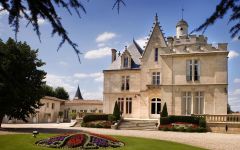Chateau Pape Clement 2019
-
Jeb
Dunnuck -
James
Suckling - Decanter
-
Wine
Enthusiast -
Robert
Parker -
Wine
Spectator -
Wilfred
Wong




Product Details
Your Rating
Somm Note
Winemaker Notes
Blend: 55% Cabernet Sauvignon, 40% Merlot, 3% Cabernet Franc
The Barrel Sample for this wine is 14% ABV.
Professional Ratings
-
Jeb Dunnuck
As to the Grand Vin 2019 Château Pape Clement, it reveals a dense purple hue to go with stunning aromatics of crème de cassis, graphite, lead pencils shavings, scorched earth, and tobacco. Beautifully balanced, with flawless tannins, this full-bodied Pessac has that rare mix of elegance and power, a great mid-palate, and again, perfect balance. It's one of the gems of the vintage and has some accessibility today given its purity and balance, yet deserves 4-5 years of bottle age and will cruise for 20-25 years or more in cold cellars. The blend is equal parts Cabernet Sauvignon and Merlot, brought up in two-thirds new French oak.
-
James Suckling
Crushed-stone and berry aromas with some blackberry and black-tea character. Just a touch of smokiness. Sweet fruit, too. This is so refined, subtle, and beautiful for Pape with full body, ultra-fine tannins and a succulent finish. The center-palate is dense and complete. Goes on for minutes. So subtle and refined, focused and classy.
-
Decanter
Continuing the strong performance of Pape Clement over recent vintages. Violet edging around the glass, and a supple tannic hold that both constricts and expands the fruit through the palate, giving a sense of momentum. There is a firm tannic grip, given drama by notes of black pepper and bitter chocolate, and a slate textured finish to slow things down and hold the flavour. Malolactic fermentation in barrels (60%) new, and ageing in both barrels (90%) and larger oak casks. Petit Verdot and Cabernet Franc are planted in the vineyard, but not yet in the 1st wine. Certified bee-friendly. Tasted twice, two weeks apart, excellent both times.
Barrel Sample: 95 -
Wine Enthusiast
Created by the 14th-century Pope, Clement V, this estate is now owned by Bernard Magrez. This latest release shows the quality of the property, a wine that is set for long aging. Ripe black fruits are matched by the wine’s structure and density. Cellar Selection
-
Robert Parker's Wine Advocate
The 2019 Pape Clément has turned out well in bottle, delivering a rich bouquet of cherries, blackcurrants, plum liqueur and blackberries mingled with notions of burning embers, licorice and a nicely integrated framing of new oak. Full-bodied, deep and concentrated, it's a layered, fleshy wine, with a deep core of ripe but lively fruit, plenty of powdery tannin and a long, expansive, discreetly heady finish. This is a powerful, dramatic Pessac with a transatlantic accent and will drink well with only a few years' bottle age.
-
Wine Spectator
Quite rich, with an exotic hint to the boysenberry, plum and mulberry fruit flavors, which are carried by a velvety structure. Features a very stylish backdrop of apple wood, anise and fruitcake notes that adds more bling. This doesn't have the drive for serious cellaring, but it's still pretty gorgeous. Cabernet Sauvignon and Merlot.
-
Wilfred Wong of Wine.com
COMMENTARY: Chateau Pape Clement is one of the most heralded Pessac-Léognan chateaux. The 2019 vintage is powerful and elevated. Enjoy its aromas of bold, ripe fruit and oak nuances with the first cut from a prime rib.
Other Vintages
2022-
Jeb
Dunnuck -
James
Suckling - Decanter
-
Robert
Parker
-
Wine
Enthusiast -
James
Suckling - Decanter
-
Robert
Parker -
Jeb
Dunnuck
-
James
Suckling - Vinous
-
Jeb
Dunnuck -
Wine
Enthusiast - Decanter
-
Wine
Spectator -
Robert
Parker
-
Jeb
Dunnuck -
James
Suckling -
Wine
Enthusiast -
Wine
Spectator -
Robert
Parker - Decanter
-
James
Suckling -
Wine
Spectator -
Wine
Enthusiast -
Robert
Parker -
Jeb
Dunnuck - Decanter
-
James
Suckling -
Jeb
Dunnuck -
Wine
Spectator -
Robert
Parker -
Connoisseurs'
Guide -
Wine
Enthusiast - Decanter
-
James
Suckling -
Jeb
Dunnuck -
Robert
Parker - Decanter
-
Wine
Spectator -
Wine
Enthusiast
-
James
Suckling -
Jeb
Dunnuck -
Robert
Parker - Decanter
-
Wilfred
Wong -
Wine
Enthusiast -
Wine
Spectator
-
Robert
Parker -
James
Suckling
-
Robert
Parker -
Wilfred
Wong -
Wine
Spectator -
Jeb
Dunnuck -
Wine
Enthusiast -
James
Suckling
-
Robert
Parker -
Wine
Spectator -
Wine
Enthusiast -
James
Suckling
-
Robert
Parker -
James
Suckling -
Wine
Spectator -
Wine
Enthusiast - Decanter
-
Robert
Parker -
James
Suckling -
Wine
Spectator - Decanter
-
Jeb
Dunnuck -
Wine
Enthusiast
-
Robert
Parker -
Wine
Enthusiast -
James
Suckling -
Connoisseurs'
Guide -
Wine
Spectator
-
Robert
Parker -
Wine
Enthusiast -
Wine
Spectator
-
Robert
Parker -
Connoisseurs'
Guide -
Wine
Enthusiast -
Wine
Spectator
-
Robert
Parker -
Wine
Spectator -
Wine
Enthusiast -
Wine &
Spirits
-
Robert
Parker -
Wine
Spectator -
Wine
Enthusiast
-
Wine
Spectator -
Robert
Parker -
James
Suckling
-
Robert
Parker
-
Robert
Parker -
Wine &
Spirits
-
Robert
Parker -
Wine
Enthusiast -
James
Suckling -
Wine &
Spirits -
Wine
Spectator
-
Robert
Parker -
Wine
Spectator
-
Wine
Spectator -
Robert
Parker



Chateau Pape Clément owes its name to its most illustrious owner. A man of the cloth born in 1264, Bertrand de Goth became Bishop of Comminges, in the Pyrenees Mountains, at the age of 31; he later became Archbishop of Bordeaux in 1299.
He then received as a gift the property in Pessac, the Vineyard de La Mothe. Taken by a passion for the vine, he continually took part personally in equipping, organizing and managing the domain in accordance with the most modern and rational practices. Nevertheless, on 5 June 1305 the cardinals met in a conclave in Pérouse and appointed him to succeed Pope Benedict XI, who had passed away prematurely after only eleven months of reign. Bertrand de Goth took the name of Clement V.
Supported by Philip IV, it was he who decided in 1309 to move the papal court to Avignon, thus breaking with Rome and its battles of influence. During this same period, the weight of his responsibilities led him to relinquish his property, giving it to the Archbishop of Bordeaux. Henceforward, the vineyard was to be known to posterity under the name of this enlightened pope.
The early period
Management under the clergy brings modernity The grateful Church perpetuated Pope Clement's work. Each archbishop in turn turned to modernity and technical progress, to the point of the wine estate becoming a model vineyard. In addition to especially early harvests, which remain one of its
special characteristics, Chateau Pape Clément is without a doubt the first vineyard in France to align vine stock to facilitate labour.
After the Revolution
At the end of the 18th century, the Archbishop of Bordeaux was dispossessed of his property. The papal vineyard became part of the public domain.
The 20th century
8 June 1937 was a dark day in the vineyard's history, when a violent hailstorm
destroyed virtually the entirety of the estate. Two years later, Paul Montagne bought
it and gradually brought it back to life. Thanks to his efforts, the vineyard returned to
its former rank and stood up to the surge in urbanization.
His descendents, Léo Montagne and Bernard Magrez, perpetuate this secular
tradition so that Chateau Pape Clément wines continue to delight the wine-lovers of today and tomorrow.
